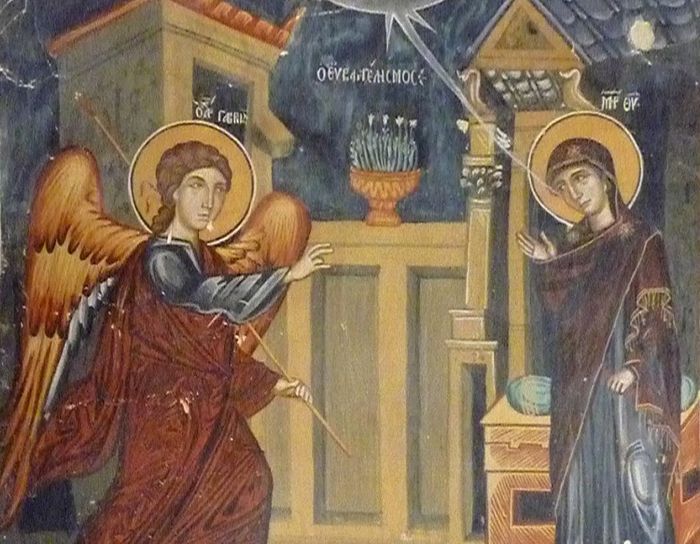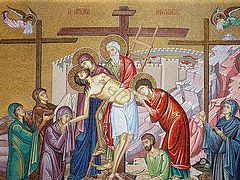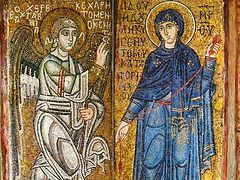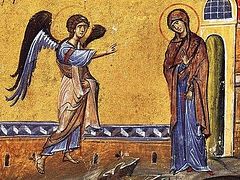This year the Annunciation, celebrated on March 25/April 7, falls on Holy Saturday. Graduate of the Sretensky Theological Seminary Reader Seraphim Appatov speaks about the liturgical and other particularities of the day, given that Holy Saturday is coinciding with one of the Twelve Great Feasts.
The Annunciation is one of the Twelve Great Feasts of the Church. The greatness and significance of this feast is fascinating not only from a theological and historical point of view, but also from the liturgical side. The date of the feast falls within the period of Great Lent, Holy Week, and Pascha. But, unlike other feasts that are transferred to another day if they fall during Holy Week or on Pascha, the services of the Annunciation are combined with all these services, including Pascha. The combination of the feasts of Pascha and the Annunciation is called Kyriopascha (Greek: Κύριο Πάσχα—the Lord’s Pascha).
This year, the Annunciation falls on Holy Saturday—the eve of Pascha. And, as was said above, the services for the feast are not transferred, but coincide with the services of Holy Friday and Holy Saturday. The colors of the vestments during these services will not be black (as it should be on the last days of Holy Week), and not blue (as for feasts of the Theotokos), but purple.
Friday afternoon, March 24/April 6
The celebration of the Annunciation begins with the Vespers that is celebrated during the day on Holy Friday. At this service are sung stichera to the Crucifixion of Jesus Christ, and of the feast of the Annunciation, of the announcement to the Virgin Mary by the angel of the joyous news of the birth of the Son of God. Paramoia (readings from Sacred Scripture) containing indications and prophecies of the suffering of Jesus Christ, and also prophecies about the Mother of God (for the feast of the Annunciation) are read during the service. The Epistle and Gospel are also read after the paramoia, but only those appointed for Holy Friday, that is, on the suffering, Crucifixion, and burial of our Lord Jesus Christ.
At the end of Vespers, the troparion of the Annunciation: “Today is the beginning of our salvation,” is sung, after which the holy Plaschanitsa is carried out to the middle of the church during the singing of the troparion “The Noble Joseph.”
After Vespers, Small Compline with the canon “On the Crucifixion of the Lord and the Lamentation of the Most Holy Theotokos,” the work of Simeon the Logothete, is appointed. In practice, the canon is read immediately after the placing of the Plaschanitsa. With the reading of this wondrous canon, Vespers ends, and everyone disperses, to again gather in church in a little while.
Friday evening, March 24/April 6
The Matins of Holy Saturday is celebrated on Friday evening, and its hymns are also combined with the hymns of the Annunciation. After the Six Psalms, the troparia of Holy Saturday: “The Noble Joseph,” “When Thou didst descend to death, O Life immortal,” and “Unto the Myrrh-bearing Women,” are sung, as well as the troparion of the Annunciation.
Then, in the middle of the church before the Plaschanitsa, the clergy and choir serve the Lamentations, that is, the verses of the seventeenth kathisma with special, wondrous refrains on the burial of Christ, His descent into Hell, the coming of the Myrrh-bearing Women, and also on the coming Resurrection. After the Lamentations, the Resurrectional troparia “The assembly of angels” [the Evlogitaria—Trans.] are sung.
Then, for the sake of the feast of the Annunciation, the polyeleos (verses of special festal psalms) is served, as well as the magnification of the Annunciation, “With the voice of the archangel we cry to Thee,” and the Gospel for the feast of the Theotokos is read (Lk. 1:24-38).
An integral part of Matins is the canon. Two canons will be read on this day—that of the Annunciation and that of Holy Saturday. The first canon is characterized by the fact that in its structure it resembles a conversation between the Theotokos and the angel. The second canon is filled with the most profound theological and dogmatic contents about what happened at the moment that Christ was placed in the tomb.
After the Great Doxology, the Plaschanitsa is carried around the church with the singing of “Holy God, Holy Mighty, Holy Immortal,” and then an excerpt from the book of the Prophet Ezekiel about the resurrection of the dead is read, and also the Epistle and Gospel for Holy Saturday.
Saturday morning, March 25/April 7
The usual Hours are served in the morning on Holy Saturday, and then Vespers with the Liturgy of St. Basil the Great. Stichera for the Resurrection, Holy Saturday, and the Annunciation are sung at Vespers. After the entrance with the Gospel, the fifteen paramoia of Holy Saturday are read, during which, in ancient times, the Baptism of catechumens was celebrated, that is, those who have been preparing themselves to receive this Sacrament for some time. There are two Epistle readings at this service: for Holy Saturday and for the Annunciation. After them, the clergy re-vest in white vestments.
Then there is the reading of the Gospels. One of them speaks of the appearance of the angel, and then of the Risen Christ to the Myrrh-bearing Women, of the fear of the guards standing at the tomb of the Lord, and on Christ’s commandment to the disciples to go preach to all people. The other tells about the Annunciation of the angel to the Virgin Mary in Nazareth.
Then continues the Liturgy of St. Basil the Great
Regulations on food
As for the rules on food, it is not blessed to eat fish and oil this day—permission is given only for wine for the sake of the feast.
In this way we can participate in the wonderful services of Holy Week, and especially of Holy Friday and Holy Saturday, and this year these services are even more decorated with the hymns of the feast of the Annunciation.




